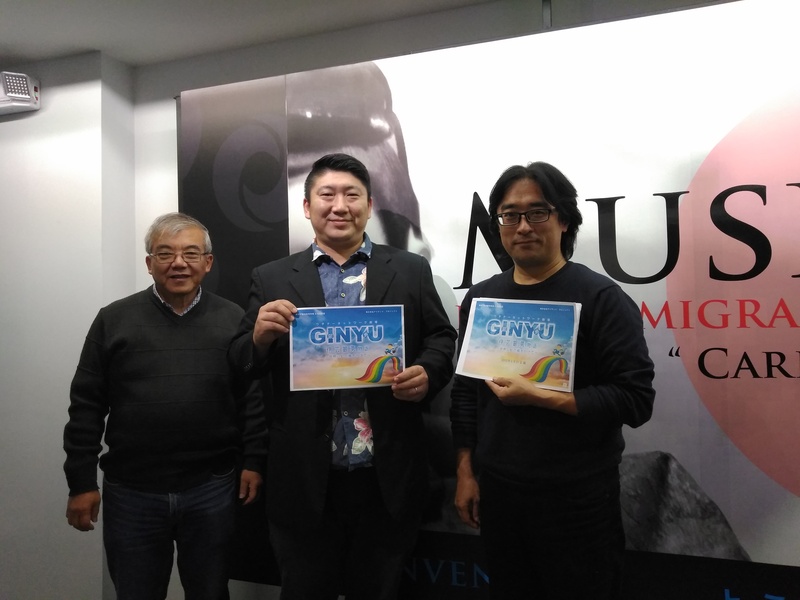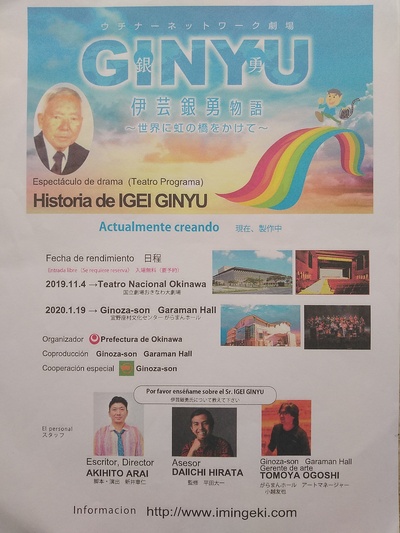Ginyu Igei, the sensei and patriarch of the Nikkei community in Peru, has a life story to tell and it will be this November 4, 2019. In his homeland, Okinawa, the play Ginyu Igei Monogatari (The Story) will premiere by Ginyu Igei) , which will portray Ginyu's life in Peru. Those behind this initiative are 3 Japanese: Akihito Arai, Tomoya Ogoshi and Daiichi Hirata, who fulfill the roles of director and screenwriter, artistic manager and supervisor for this project. For the first time, Akihito Arai and Tomoya Ogoshi visited Peru a few months ago, to learn more about Ginyu's life, through the Igei family and, especially, his son Jorge Igei, who is the current director of the Museum. of Japanese Immigration to Peru “Chiyoteru Hiraoka”.
The life of Ginyu Igei
Ginyu Igei was born in 1908 in the village of Kin (now Ginoza) in Okinawa Prefecture. He graduated as a teacher from the Okinawa Normal School and in 1934, he came to Peru with his wife to work as deputy director at the Chancay Nikko Japanese school. In Peru, Ginyu worked in several Japanese schools, until the Second World War broke out. All Japanese schools in Peru closed and clandestine schools, the gakuen, appeared. Ginyu opened the Igei Gakuen in Lince and, due to the lack of school textbooks, he himself printed the books with a mimeograph machine, which had the approval of the Ministry of Education of Japan and were paid for, in part, with what he earned on the farm. To survive, Ginyu worked in the fields and repaired pianos. A few years after the end of the war, Ginyu left teaching and dedicated himself to actively collaborating in the Peruvian-Japanese community. He received various decorations for his prolific leadership work, including decorations from the government of Japan and the prefecture of Okinawa. Ginyu Igei left for eternity in 2005.
Regarding the play Ginyu Igei Monogatari , the newspaper Peru Shimpo published on August 25, 2019 (online edition, August 26) an interview with Akihito Arai and Tomoya Ogoshi, taking advantage of their recent visit to Peru. As editor of the newspaper, I had the opportunity to meet them personally and learn a little more about this project and also know the importance of Uchinaanchu (Okinawa) immigration to Peru for Okinawa and their interest in learning more and connecting with their descendants.
How did Akihito Arai and Tomoya Ogoshi become interested in Ginyu Igei?
The interest was born at a Kenji Igei concert in January of this year, at the Garaman Hall in Ginoza (Okinawa), where Ogoshi works. Kenji is a Nikkei singer-songwriter who is also the grandson of Ginyu and son of Jorge. In one of his songs ( Our Dear Uchina ), photos of his oba and oji caught Ogoshi's interest in the life of Ginyu Igei. By April, Ogoshi teamed up with Arai, a producer of plays about immigration, to present the story of Ginyu Igei in a contest organized by the prefecture. They competed against five other companies, but their project won. Igei Ginyu Monogatari is the third project that Arai writes for this contest and that is a winner, like the previous ones. The first project was about the life of Shinsuke Taira (2017), an Okinawan who emigrated to Hawaii and who was related to Kyuzo Toyama, the father of Okinawan immigration; and the second, on the origin of the Uchinaanchu Taikai (2018).
Who is sponsoring this project?
Igei Ginyu Monogatari is sponsored by the prefecture of Okinawa and the collaboration of Ginoza Son, Ginyu Igei's hometown, who joined the project after the project was chosen. Ginyu Igei is considered an honorary citizen of Ginoza.
Why does Okinawa Prefecture organize this type of contest?
Every 5 years, thousands of uchinaanchu (Okinawans) congregate at the Uchinaanchu Taikai in Okinawa. But why do they meet? Or what did the first Okinawan immigrants do abroad? many young Okinawans ask themselves. That is why the Okinawa prefecture seeks to answer them through theatrical works.
First visit to Peru and first impressions
For 10 days (August of this year, 2019), Arai and Ogoshi have been visiting Peru and this has been their first trip. His main contact has been the Igei family. They claim to have been impressed with the development of Nikkei food. On the other hand, although there is interest on the part of Okinawans to travel to South America, it is only for a short time and not to permanently reside. For Ogoshi, “the food is delicious, there are countless fruits, but if I didn't have to deal with the traffic, it would be paradise.” Arai adds: “I feel very excited by the words of encouragement that we have received from different sides, from whom we have had contact, and I will strive to make this work a success and, if possible, bring it to Peru at some point.”
An “uchinaanchu network” that began in 1969 with Ginyu Igei
In July 1969, the documentary Hawaii ni Ikiru (Life in Hawaii) was screened in Hawaii, commemorating 65 years of Okinawan immigration to Hawaii. This documentary was shown in Peru, Brazil, Argentina and Bolivia; thanks to the “uchinaanchu network” started by Ginyu Igei.
When Igei found out about the existence of this documentary from Takeo Kanashiro (Los Angeles, USA), he had to bring permission from Hawaii to be able to screen it in Peru. Igei traveled to Hawaii, where Taro Higa, the producer of the documentary, was, who granted him authorization, in exchange for helping him spread it in South America. Upon arriving in Peru, this documentary was screened in several locations, such as the Peru Shimpo auditorium in Jr. Puno and the premises of the Okinawan Fraternal Association (AFO) in Jr. Miro Quesada. True to his word, it was also screened in Brazil, Bolivia and Argentina.
It was sponsored by Shintetsu Kinjo of Kinjo Travel Service of that time, who promoted the activities within the different countries.
* * * * *
WORK DATA
The play Igei Ginyu Monogatari (The Story of Ginyu Igei) will have two performance dates: November 4, 2019 (Okinawa National Theater) and January 19, 2020 (Garaman Hall by Ginoza Son).
To learn more details about the work, you can visit this link (Japanese).
*This is an article adapted for Discover Nikkei, based on the interview I conducted for the Peru Shimpo newspaper and published on Sunday, August 25, 2019.
© 2019 Milagros Tsukayama Shinzato / Peru Shimpo







